Overall video entertainment spend in the UK is expected to reach £10 billion by 2018, averaging 2% annual growth between 2014 and 2018. Pay-TV and subscription VoD services will be the key drivers, with transactional digital video showing moderate growth. Box office remains steady though packaged video is set to lose £1 billion in consumer spend between 2013 and 2018, according to the latest research from Futuresource Consulting.

“The UK video market has undergone significant change in the last two years, driven by increasing digital service choice, significantly improved infrastructure and connected device uptake, says David Sidebottom, Senior Market Analyst at Futuresource Consulting. “As the evolving retailer and service provider offerings continually shape consumer behaviour, the UK is becoming one of the most dynamic digital video sectors globally.”
Total consumer spend on video in the UK grew by 4% in 2013, to exceed £9 billion, with a further 3% growth expected in 2014. Digital video service penetration is driving this growth, both from the increased on-demand capability of Pay-TV operators and growth in subscription video on demand (SVoD) services. Sky recently announced that it will be ramping up its on-demand service with plans to sell digital copies of the latest movie releases, to keep, and also send a DVD in the post as part of the same service.
“Sky continues to evolve and provide increased consumer viewing choices in the wake of increasing competition from other Pay-TV providers and newer SVoD services, as it continues to convert its near 10 million to on-demand users” says Sidebottom.
The UK remains one of the most dynamic Pay-TV markets in the world, maintaining both a strong free-to-air offering and competitive Pay-TV environment. Pay-TV homes reached 57% penetration in 2013 and at over £33 per month, ARPU is one of the highest in the world, driven by sports and an impressive choice of content and viewing options on the leading services.
Overall home video growth remained flat in 2013 at just over £2 billion, with online SVoD services the key reason for this improved performance. SVoD service growth of 166% more than offset the 7% decline in packaged sell-through, although the moderate growth in transactional digital video struggled to offset the considerable decline in packaged rental.
“Experiencing a 9% decline in retail value in 2013, the overall UK packaged video market performed better than most European countries, with performance more in line with the USA,” says Sidebottom. At almost £1.6 billion, the UK remained the third largest packaged video market in the world and the largest in Europe, although this title could be challenged by Germany in 2014″
Focusing on the digital video segment, the overall UK digital video market grew by 47% in 2013, to reach almost £450 million, driven largely by the continued momentum of online SVOD subscriber growth which will help the overall digital sector exceed £1 billion in 2017.
The growth in SVoD is largely due to the success of Netflix, which continues to gain momentum and increase its profile.
“Netflix has established itself as the leading player in the UK SVoD sector, primarily due to strong TV franchises and wide availability. But with the launch of Amazon Prime Instant Video, integrating Lovefilm and effectively replicating Amazon’s US video strategy, combined with the newer movie focus of Sky’s Now TV, the consumers choice of premium video viewing has never been greater, which in turn is driving industry revenues”.


